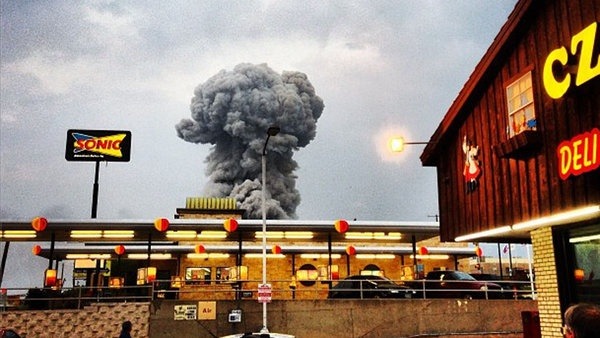After the September 11 attacks, U.S. chemical facilities became a priority for security agencies like the FBI and the CIA. The manager of Washington, D.C.’s sewage treatment plant told a reporter that he couldn’t sleep at night knowing the facility stored ten 90-ton railcars of chlorine gas. Within three months, the plant was converted to sodium hypochlorite, eliminating a poison gas threat to 1.7 million in our nation’s capital.
Still, most high-risk chemical plants have yet to implement safer alternatives. Approximately 470 facilities each put 100,000 or more people at risk of a catastrophe triggered by terrorist attack, natural disaster, malfunction, or simple human error.
The cost of inaction is unfathomable. Reports by the U.S. Naval Research Laboratory estimate that just one railcar of chlorine gas could result in 100,000 casualties in 30 minutes; Risk Management Solutions estimates that a chlorine spill could result in “42,600 total casualties, over 10,000 of which [would be] fatal.”
One year after September 11, a bipartisan bill was unanimously adopted by the Senate Environment and Public Works Committee. It aimed to secure chemical facilities and protect surrounding communities by requiring plants use safer chemical processes, otherwise known as “Inherently Safer Technologies” (IST). At the same time, then-Administrator of the EPA Christine Todd Whitman, a George W. Bush appointee, proposed using the Clean Air Act’s “Bhopal amendment”—named after the 1984 Union Carbide disaster in India that killed 20,000 people. This never-before-used provision would authorize the EPA to issue enforceable disaster prevention regulations.
The EPA proposed voluntary measures over two years and plans to wait until 2016 to finalize enforceable regulations.
Unfortunately, Senate Republicans flip-flopped to block the legislation, and President Bush scuttled Whitman’s proposal.
When Barack Obama was elected to the Senate in 2004, the vulnerability of chemical facilities had yet to be addressed and IST was gaining traction. In July 2006, as a House committee adopted a bipartisan bill to require high-risk plants to adopt IST, Obama and then Senator Joe Biden led the charge. Obama argued: “Each one of these methods reduces the danger that chemical plants pose to our communities and makes them less appealing targets for terrorists.” He added: “We cannot allow chemical industry lobbyists to dictate the terms of this debate … [or] allow our security to be hijacked by corporate interests.” Those interests included Dow Chemical, ExxonMobil and Koch Industries.
Ultimately the Republican-controlled Congress adopted a 740-word chemical-security bill as an amendment to the Department of Homeland Security’s (DHS) funding bill that exempted the majority of the 12,700 chemical plants in the EPA’s chemical disaster program and barred the DHS from requiring IST.
This decade-long failure sparked the formation of a coalition of over 100 organizations including national unions, environmental groups, public-health organizations and environmental justice groups (e.g., Greenpeace), all urging the president to use the authority that Whitman proposed in 2002. In May of 2012, then-EPA Administrator Lisa Jackson assigned a team to evaluate the proposal and the coalition’s formal petition.
Little happened until April 17, 2013, when a fertilizer facility in West, Texas, exploded, killing 15 people and injuring 200 others; just a few months later, on August 1, 2013, Obama issued an executive order directing all federal agencies to develop ways to modernize chemical-plant safety and security within nine months. In May of this year, the agencies delivered their report to the White House. The EPA proposed voluntary measures over two years and plans to wait until 2016 to finalize enforceable regulations.
On July 31, the EPA formally opened a public-comment period through October 29 inviting feedback on potential regulations. While the EPA’s proposed policies do indeed include prevention requirements, such as IST, the agency will clearly need to hear much more from the public, especially given that Obama once said: “IST is an integral part” of a comprehensive program, “without it, we’re leaving a huge gap in our ability to manage the risks that these facilities represent.” Every year we fail to act, we will lose more workers, first responders and local residents to tragedies that were preventable.
If the use of IST sounds like common sense, you’re far from alone. A national poll by Lake Research Partners confirmed such chemical-safety requirements are favored by a strong majority of likely voters, Republicans and Democrats alike. Making these plants safer will also create jobs and stimulate local economies. According to an independent firm, the 2009 House-passed bill would have created 8,000 new jobs; and when the Center for American Progress surveyed chemical facilities that converted to safer processes, a third expected to save money because of the switch.
At the EPA’s current pace, it is likely that another tragedy will occur before the agency finalizes any new requirements. Until now, the responsibility for blocking prevention rested with the oil and chemical lobby and with their allies in Congress. If this administration leaves office failing to make prevention a requirement rather than the voluntary option it is today, it will share responsibility for future disasters with those who have blocked prevention for more than a decade.
Rick Hind is the legislative director of Greenpeace.







0 Comments
Trackbacks/Pingbacks